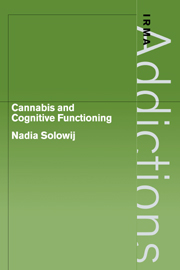Book contents
- Frontmatter
- Contents
- Series editor's preface
- Author's acknowledgements
- 1 Statement of the problem
- PART 1 A REVIEW OF THE LITERATURE
- PART 2 RESEARCH
- 7 An event-related potential study of attentional processes in long-term cannabis users
- 8 An investigation of the effects of frequency and duration of cannabis use
- 9 An investigation of the reversibility of cognitive impairment in ex-cannabis users
- 10 A single case study of cessation of cannabis use
- 11 Anxiety, psychopathology and the qualitative experience of long-term use of cannabis
- 12 Summary, synthesis and conclusions
- Appendix
- References
- Index
8 - An investigation of the effects of frequency and duration of cannabis use
from PART 2 - RESEARCH
Published online by Cambridge University Press: 16 September 2009
- Frontmatter
- Contents
- Series editor's preface
- Author's acknowledgements
- 1 Statement of the problem
- PART 1 A REVIEW OF THE LITERATURE
- PART 2 RESEARCH
- 7 An event-related potential study of attentional processes in long-term cannabis users
- 8 An investigation of the effects of frequency and duration of cannabis use
- 9 An investigation of the reversibility of cognitive impairment in ex-cannabis users
- 10 A single case study of cessation of cannabis use
- 11 Anxiety, psychopathology and the qualitative experience of long-term use of cannabis
- 12 Summary, synthesis and conclusions
- Appendix
- References
- Index
Summary
Experiment 2: effects of frequency and duration of cannabis use on auditory selective attention
In Experiment 1, event-related potentials (ERPs) recorded during a complex auditory selective attention task were compared between a small and heterogeneous group of long-term cannabis users and a nonuser control group. The results indicated that compared to controls, cannabis users showed larger processing negativity (PN) to an irrelevant source of information, reflecting an inability to filter out extraneous information at an early stage of processing. Cannabis users also showed reduced P300 amplitude which was interpreted as a dysfunction in the allocation of attentional resources. The current study was designed to replicate these findings with a larger sample and to examine the effects of frequency and duration of cannabis use.
Method
Subjects
The same inclusion/exclusion criteria as those described for Experiment 1 were applied here, with the exception that regular use could be defined as at least once/month to enable the formation of a low frequency user group. The overall sample (n = 32) had used cannabis for a mean of 6.69 years (range 3–28 years) at a mean frequency of 12 days per month (range once/month to daily use). The characteristics of the entire sample and subgroups are presented in Table 8.1.
The user group was split at the median on both frequency (light: ≤ 2/week vs heavy: ≥ 3/week) and duration (short: 3–4 years vs long: ≥ 5 years) of cannabis use.
- Type
- Chapter
- Information
- Cannabis and Cognitive Functioning , pp. 152 - 169Publisher: Cambridge University PressPrint publication year: 1998

